50 years of Ibanez in the USA: the unstoppable rise of the pioneering Japanese guitar brand
How the Ibanez brand evolved in lockstep with guitar culture, leveraging artist partnerships to make new breakthroughs in design, sound and performance

Introduction
Fifty years ago, on September 1, 1972, the Japanese musical instrument manufacturer Hoshino officially formed a partnership with America’s Elger company to sell and market Ibanez guitars in the United States.
The ensuing collaboration was much more than an ordinary exporter/distributor relationship as the Japanese and Americans worked closely together, combining Hoshino’s manufacturing skills and craftsmanship with Elger’s expertise in selling instruments to American guitarists.
As the partnership evolved and grew, Ibanez eventually became one of the world’s most successful guitar brands, and the company still enjoys that status today.
The Ibanez story – as most of us know it – began that late-summer day at a European music trade show. However, the history of Ibanez guitars goes back much further than that. Hoshino Gakki Ten (“gakki ten” means “musical instrument company” in Japanese) started in 1908 when the Hoshino family decided to add a musical instrument department to its successful bookstore business.
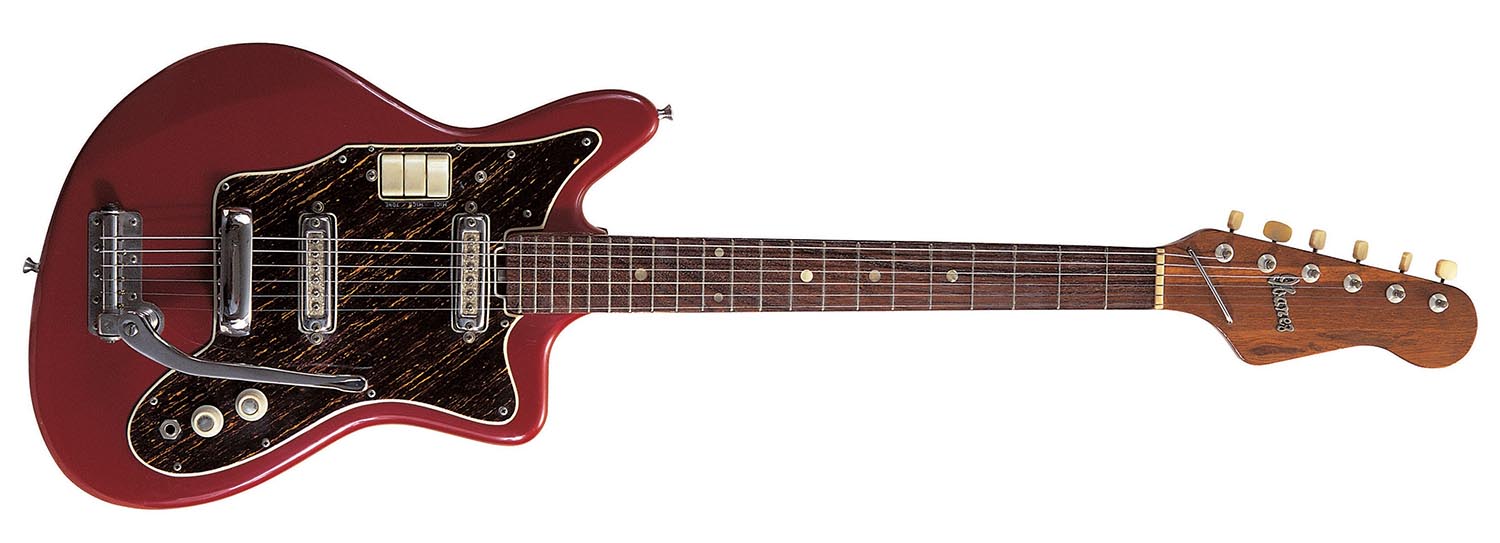
Interest in the guitar grew in Japan during the 1920s as the Hawaiian guitar craze reached Japan. Andres Segovia’s first concert in Japan in 1929 further expanded demand. Fortunately, Hoshino had started importing Salvador Ibanez guitars from Spain that same year.
As Hoshino’s business grew, the company became one of Japan’s biggest exporters of musical instruments, particularly during the mid Sixties when Beatlemania led to a significant boom in guitar sales.
In 1972, the Ibanez guitar catalog resembled a “greatest hits” collection of America’s most popular acoustic and electric guitars
The U.S. was one of the most lucrative markets for Ibanez guitars, but it was difficult and confusing to conduct business there due to a lack of centralized distribution. Instead, distribution was handled by several dozen different regional distributors, each with its own separate practices and procedures.
Get The Pick Newsletter
All the latest guitar news, interviews, lessons, reviews, deals and more, direct to your inbox!
Yoshihiro Hoshino decided to make the highly controversial move of dealing with just one agent in the U.S. to handle distribution. The most logical candidate was the Elger Company, owned by Harry Rosenbloom, who had a retail store that sold Hoshino products and who also was an importer, distributor and manufacturer.
Further sweetening the deal was Elger’s strategic location in Bensalem, Pennsylvania, about 20 miles north of Philadelphia and close to several major highways that provided quick and easy access to major shipping ports, including Philadelphia, Baltimore, Newark and New York.
When Elger and Hoshino joined forces in 1972, the Ibanez guitar catalog resembled a “greatest hits” collection of America’s most popular acoustic and electric guitars.
The acoustics were basically reproductions of Martin and Gibson models, while the electric guitars and basses included copies of various Gibsons (Les Pauls, SGs, ES-175s, ES-335 and 355s, a late-Sixties style Flying V, plus EB and Les Paul Recording basses), Fenders (Strats, Teles, Jazzmasters, P- and J-basses), Ampeg lucite guitars and basses, and Ampeg, Hofner and Rickenbacker solidbody basses.
These guitars, built by Japan’s Fujigen Gakki company, may not have been original designs, or even 100 percent accurate reproductions (for example, the Les Pauls had bolt-on necks), but they were very affordably priced and, perhaps more importantly, expertly set up by Elger’s staff when they arrived in the States, which was an unheard of practice during the early Seventies.
Although Hoshino initially wanted Elger to set up and distribute its instruments, the Japanese partners grew receptive to the Americans’ creative input and marketing ideas.

2: The new originals
Jeff Hasselberger, who started as an advertising consultant before becoming a full–time employee, and Hoshino executive Roy Miyahara were huge rock music fans, and their streetwise perspectives helped Hoshino develop guitars that were more in sync with current trends.
Over the next few years, Ibanez continued to offer predominantly copies, but the models shifted toward reproductions of more desirable vintage models instead of mirror images of current production instruments.
Ibanez’s Rocket Roll Sr. and Destroyer grabbed the attention of many guitarists, including an up-and-coming guitarist named Eddie Van Halen
New original models also started to appear as Ibanez set its sights on establishing its own identity. Ibanez gained significant momentum by 1975.
Ibanez’s excellent reproductions of Gibson’s rare late-Fifties korina Flying V and Explorer models, which Ibanez named the Rocket Roll Sr. and Destroyer, respectively, grabbed the attention of many guitarists, including an up-and-coming guitarist named Eddie Van Halen, who used a Destroyer as one of his main guitars during 1975 through 1977, including the recording of about half of Van Halen’s debut album.
Paul Stanley of Kiss, Cub Koda of Brownsville Station, Syl Sylvain of the New York Dolls and both Tom Petty and Mike Campbell of Tom Petty and the Heartbreakers played Ibanez’s “korina” models (actually made of Japanese sen). Ibanez even offered a “copy” of the legendary korina Gibson Moderne, called the Futura, which Gibson never produced and previously only existed as a patent drawing.
The company also significantly expanded its original “Artist” series models. The three 2663 models, featuring a very distinctive angular shape and arrowhead-style headstock shape, were particularly notable – a few years later this body style was renamed the Iceman.
The Artist name was fitting, as Ibanez guitars were quickly being noticed by many significant players
The Iceman also later became the basis for the popular Paul Stanley PS10 model. Steve Miller famously played a 2663TC (originally called the 2663-3P) with an unusual triple-coil pickup on his Fly Like an Eagle and Book of Dreams albums and supporting tours.
The Artist name was fitting, as Ibanez guitars were quickly being noticed by many significant players. Bob Weir of the Grateful Dead was the first artist to collaborate with Ibanez on a signature model, the 2680 and a fancier variation the 2681 Pro, which made its debut in 1975.
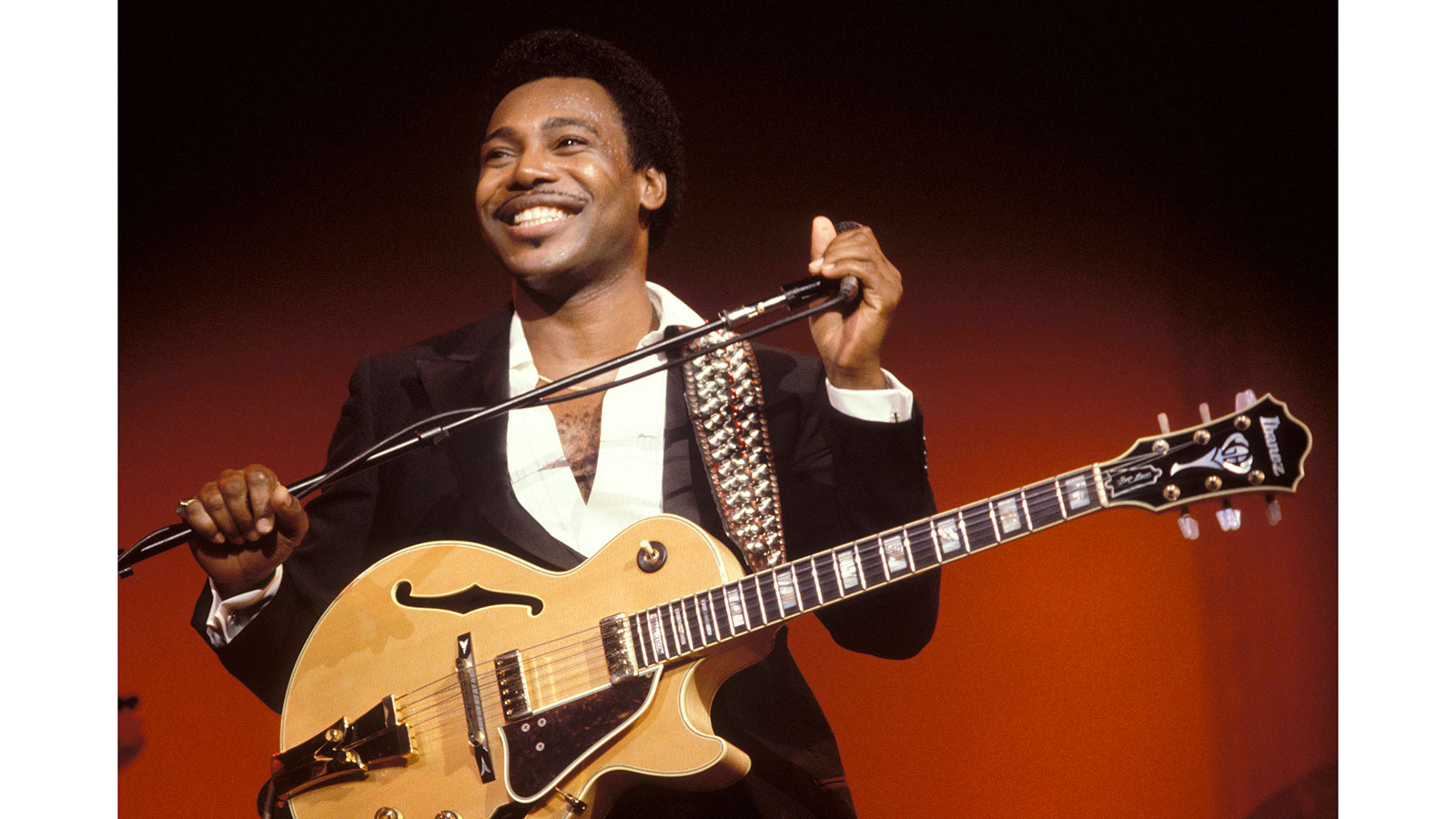
George Benson was the second guitarist to develop an Ibanez signature model – the GB10, which made its debut in 1977. Ibanez and Benson have maintained a continuous relationship since then, offering a variety of hollowbody George Benson models over the years.
Ibanez representatives aggressively promoted the company’s guitars and basses to artists during the mid Seventies to help spread the word about their instruments and solidify the brand’s reputation for quality.
Ibanez’s early focus on forging solid relationships with artists set a template for the company’s success that still remains a primary part of its practices today
Over the course of a few years, Ibanez went from featuring just one artist (Swedish jazz guitarist Rene Gustafsson) in its 1973 catalog to producing a special Professional catalog in 1976 that featured a different artist on each of its 12 pages, including Weir, Pat Simmons of the Doobie Brothers, Freddie Stone of Sly and the Family Stone, bassist Ronald LaPread of the Commodores, Carl Perkins, Randy Scruggs and more.
Ibanez’s early focus on developing new models that evolved over time and forging solid relationships with artists set a template for the company’s success that still remains a primary part of its practices today.
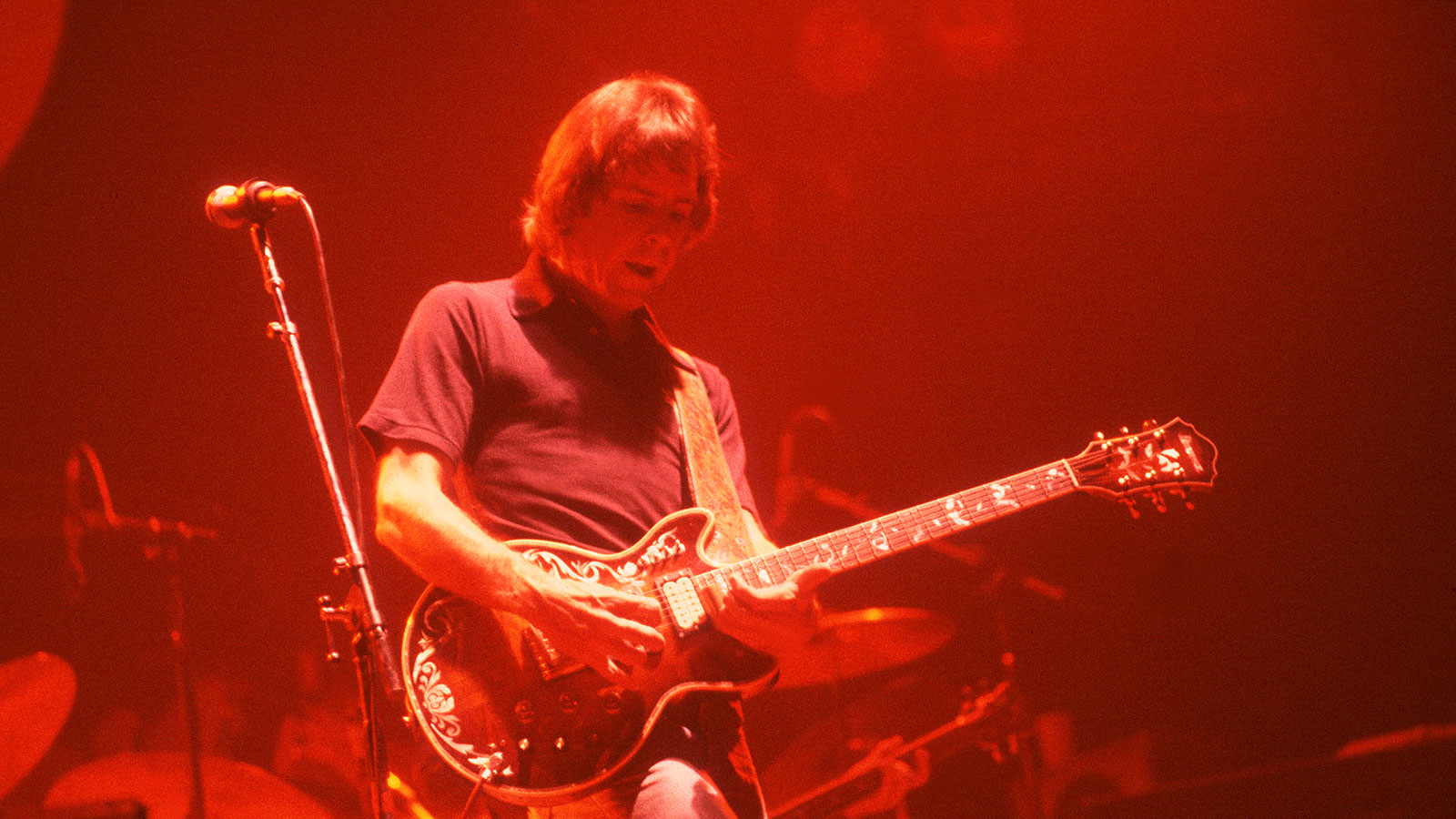
By 1978 the direct copies were gone, and Ibanez promoted several original designs in its catalog, including the Artist, Musician, Concert, Performer and Iceman Series, along with George Benson, Paul Stanley and Bob Weir signature models. In tribute to how far the company had come, the statement, “Built by the proud craftsmen of Ibanez Japan” appeared on the control cavity covers of several flagship models.
Although Gibson raised an intellectual property dispute with Ibanez and several other Japanese companies the previous year to halt production of copies of the American manufacturer’s designs, Ibanez was already several steps ahead of the competition, and its focus was now on being an innovator instead of an imitator.
Ibanez didn’t have a long legacy, so they had to innovate out of necessity. That sparked a mentality that has stuck with the company
“When the company started moving away from replica designs and found its own identity, that was an important period,” says Ibanez Communications Specialist Scott Miller.
“The people who designed early original Ibanez body shapes like the Iceman realized that the company didn’t have that long-established legacy like Gibson had with the Les Paul or Fender had with the Strat, which players were very familiar with and kept coming back to.
“Ibanez didn’t have that, so they had to innovate out of necessity. That sparked a mentality that has stuck with the company. Innovation and experimentation are very much a part of Ibanez’s DNA.”
3: The power and the passion
The electric guitar market became increasingly competitive during the early Eighties as a growing number of companies fought for market share. Ibanez maintained a competitive edge, thanks to its growing positive reputation, impressive artist roster and the breadth of its product line, which included everything from affordable entry-level instruments to stunning pro-quality guitars with unique features.
Ibanez’s guitar catalog was truly comprehensive, offering models like the Artist and Performer Series that went head-to-head with popular Gibson solidbodies, the Destroyer and Iceman Series for players who preferred eye-catching radical body shapes, the Musician Series with its versatile electronics and custom-style craftsmanship, and the Fender-style Blazer and Roadster/Roadstar Series.
Respected artists like Steve Lukather, Allan Holdsworth, Joe Pass, Lee Ritenour and Def Leppard’s Phil Collen collaborated on signature models, and Ibanez guitars and basses were regularly sighted on stage in the hands of players that included Adrian Belew, Sting, Gary Moore and John Scofield.
However, while Ibanez had assembled one of the most impressive artist rosters in the industry, the company struggled to compete with Kramer, which greatly benefitted from its relationship with Eddie Van Halen. Many up-and-coming hard rock and metal guitarists gravitated toward Kramer because of that, and Ibanez started to search for an artist association that could steal some of Kramer’s thunder.
Ibanez was in the process of radically redesigning its product lineup during the mid Eighties when the company approached Steve Vai. Although Ibanez wasn’t the only company courting the guitarist, Vai agreed to work with Ibanez, thanks to the company’s desire to design an instrument from scratch rather than force him to use an already-existing model.
The timing couldn’t have been better, as Vai had just joined David Lee Roth’s post-Van Halen band, which catapulted Vai from cult guitar hero to bona fide rock star.
The product of Vai’s collaboration with Ibanez was the JEM777, which made its debut at the Winter NAMM Show in Anaheim, California, in 1987. Numerous companies were building hot-rodded “super Strats” at the time, which were inspired by Eddie Van Halen’s “Frankenstein” guitar, but the JEM777 was like a sleek, sexy Lamborghini Countach, while the competitions’ models were like a ’57 Chevy street rod.
The JEM777 was like a sleek, sexy Lamborghini Countach, while the competitions’ models were like a ’57 Chevy street rod
Notable features included a deep cutaway that provided unrestricted access to all 24 frets, eye-catching day-glo finishes in hot pink, yellow and green, pink high-output custom DiMarzio pickups, Ibanez’s outstanding Edge double-locking tremolo sitting in a routed “lion’s claw” cavity that enabled radical rising pitch capabilities and a distinctive “monkey grip” cutout in the upper bass bout.
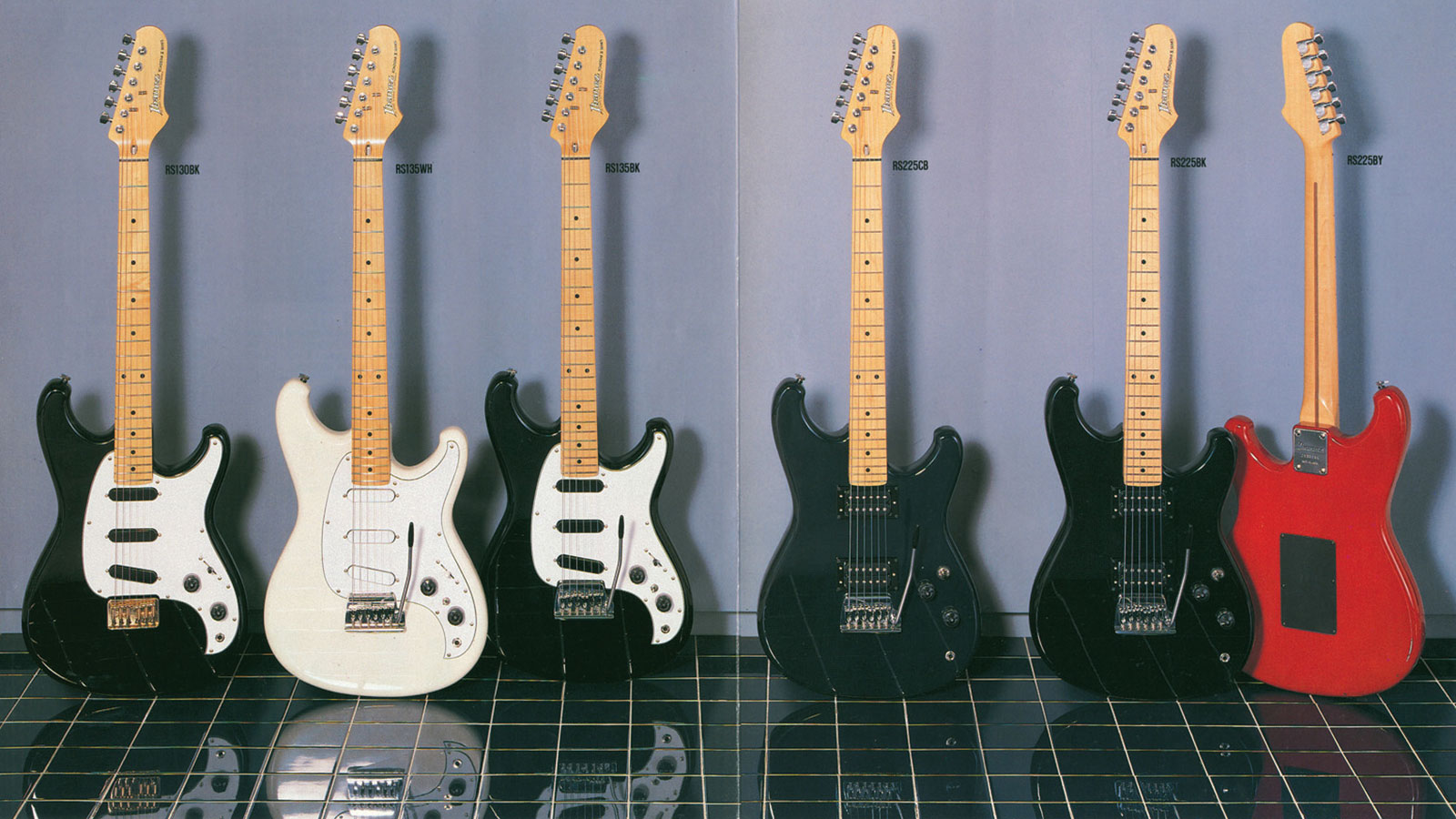
But the Steve Vai JEM777 signature guitar wasn’t the only trick up Ibanez’s sleeve. At the same time the company introduced several radical new designs that similarly shook up the super Strat marketplace.
This included the RG550, which had a similar body shape to the JEM model and the ultra-slim, fast-playing Wizard neck, several Roadstar II PRO540 models – the Saber, Radius and Power – which featured radical tapered and contoured body profiles, and the modernistic Maxxas model with its extreme sharp cutaway horn points, airfoil-style sculpted body contours, semi-hollow body design and revolutionary all-access neck joint with a slim, rounded heel and countersunk screws that eliminated the traditional neck plate.
Vai and Satriani became the leading figureheads of the instrumental shred guitar phenomenon
The Maxxas and Power models were short-lived, but the Saber, Radius and RG550’s legacies live on today via Ibanez’s S, Joe Satriani and RG models, respectively.
Vai’s endorsement of Ibanez guitars led to a flood of new, highly talented guitarists joining forces with the company during the late Eighties, with notable artists including Paul Gilbert, Frank Gambale and Reb Beach, who all went on to develop signature models.
The most significant addition to Ibanez’s artist roster at this time was Joe Satriani, who was Vai’s good friend and former guitar teacher. Satriani’s endorsement was officially announced in January 1988.
Once again, the timing was perfect as Satriani had just released his second instrumental album, Surfing with the Alien, which became a surprise hit reaching a peak of Number 29 on the Billboard 200 album chart and remaining on the chart for 75 weeks.
Vai and Satriani became the leading figureheads of the instrumental shred guitar phenomenon, and their use of Ibanez guitars made Ibanez the go-to brand for thousands of aspiring shredders.
4: Shifting gear
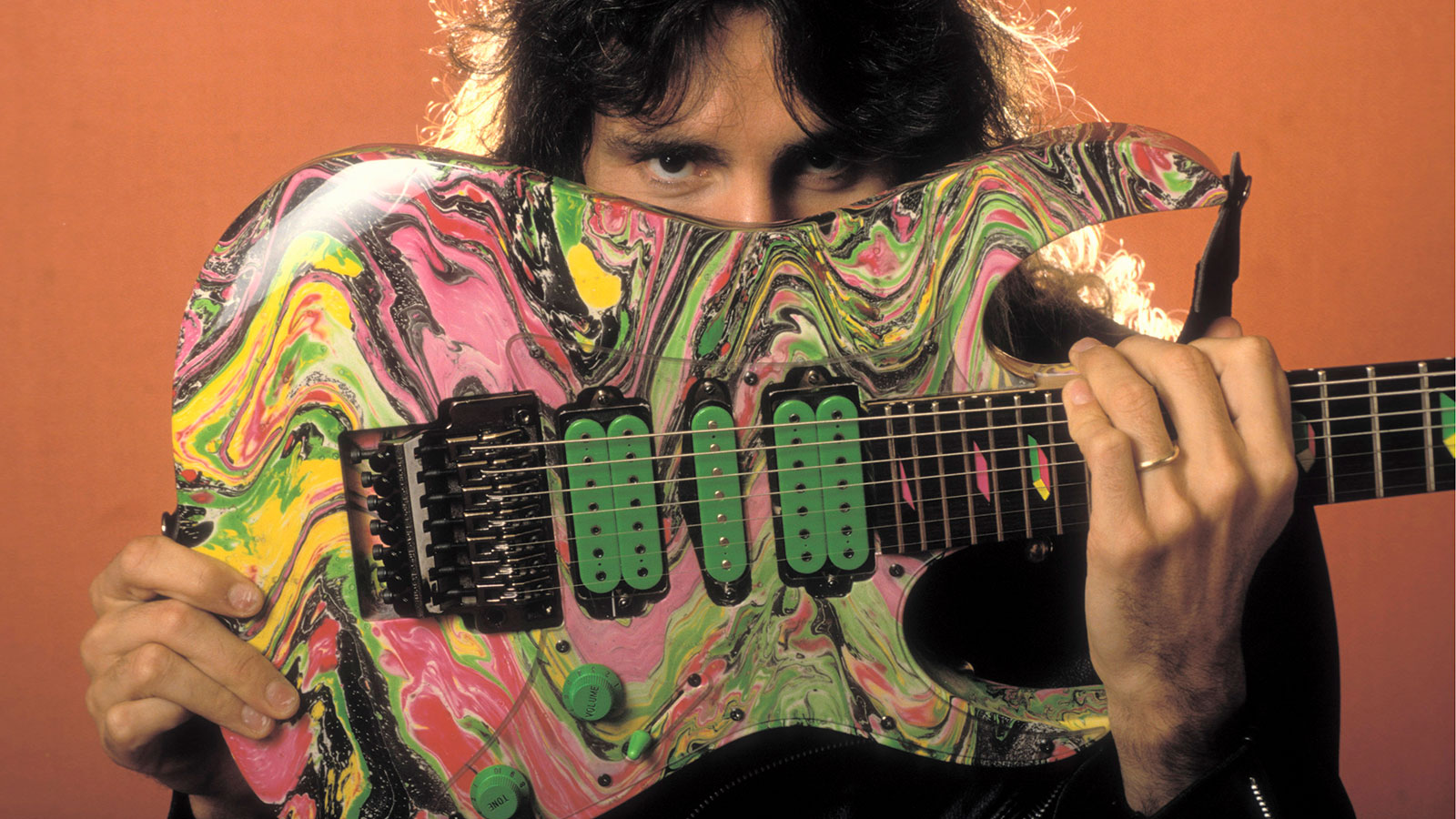
Ibanez ascended to status as one of the world’s top guitar companies during the late Eighties, and that momentum continued during the beginning of the Nineties. Ibanez started assembling several models in America in 1988 and also opened a custom shop in Hollywood that same year to accommodate its growing artist roster.
New models were released at a quick pace, but a few stalwart models like the Artist Series solidbody and semi-hollow guitars and George Benson signature hollowbodies showed that company had not forsaken its past.
When grunge hit, many guitar companies struggled to adjust to the rapid change and a few went out of business
Ibanez entered the Nineties with several bold statements, including the introduction of the JS Series Joe Satriani signature model guitars and the world’s very first production seven-string solidbody electric, the Steve Vai Universe (UV77, UV7P and UV7).
But although the Universe played an important role on Vai’s highly successful instrumental album Passion and Warfare, released the same year, the model did not sell well initially and was discontinued by 1994.
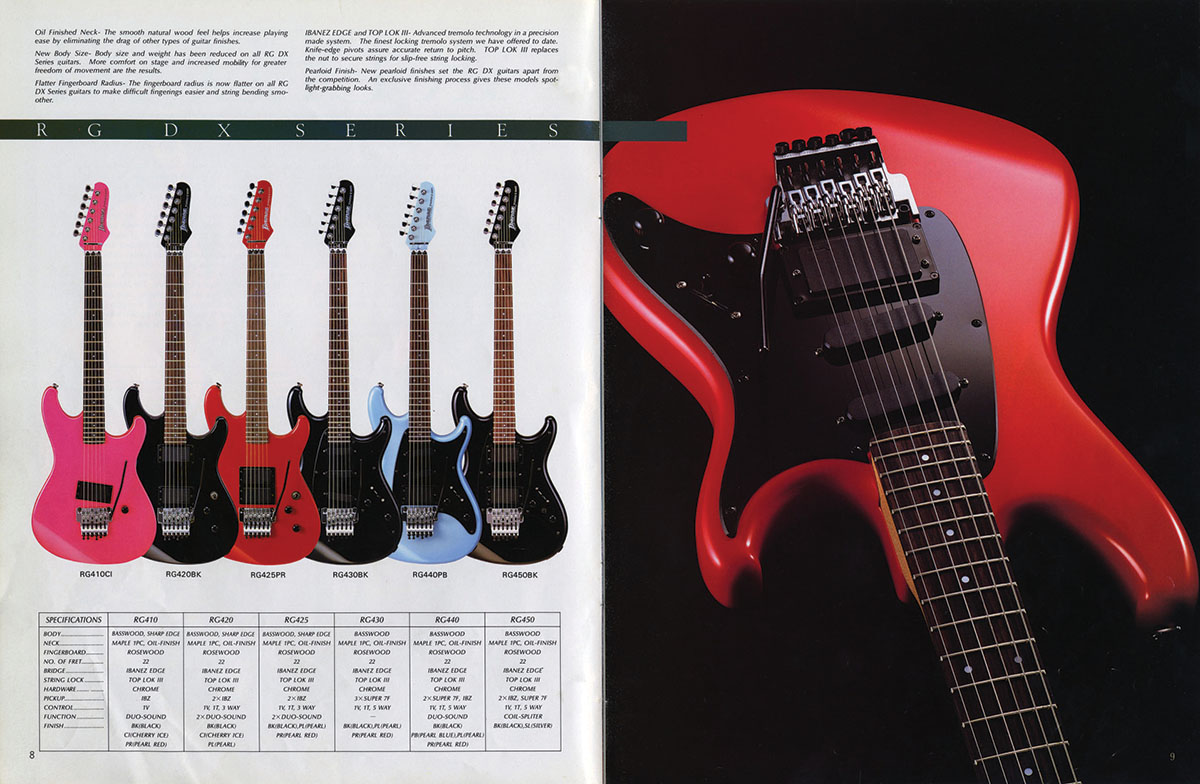
Changing musical tastes precipitated by the incredible success of Nirvana’s Nevermind album in early 1992 threatened to make Ibanez as passé as spandex tights and teased Aqua Net hairstyles. Seemingly overnight, interest in super Strat guitars with locking vibrato tailpieces plummeted.
Many guitar companies struggled to adjust to the rapid change and a few went out of business. Thanks to Ibanez’s ability to adapt and its history of developing new models, it took the company only a few years to respond with the Talman and Ghostrider Series, which made their debut in 1994 and sported features like lipstick-tube single-coil and vintage-output humbucking pickups.
In 1994, the same year Ibanez discontinued the seven-string Universe model, Korn released their debut album. Both of the band’s guitarists, Munky and Head, played Universe models that they had bought cheap on the used market.
However, instead of using the model for its intended shred styles, Korn employed the Universe’s extended bass range to great effect on down-tuned rhythm parts.
Korn went Gold in 1995, and as the band’s popularity increased, so did demand from guitarists for seven-string models. Ibanez revived the Universe in 1996, and several more affordable RG series seven-strings followed suit in 1998 before Ibanez finally awarded Korn’s contribution to the model’s revival by issuing the K7 signature models in 2001.
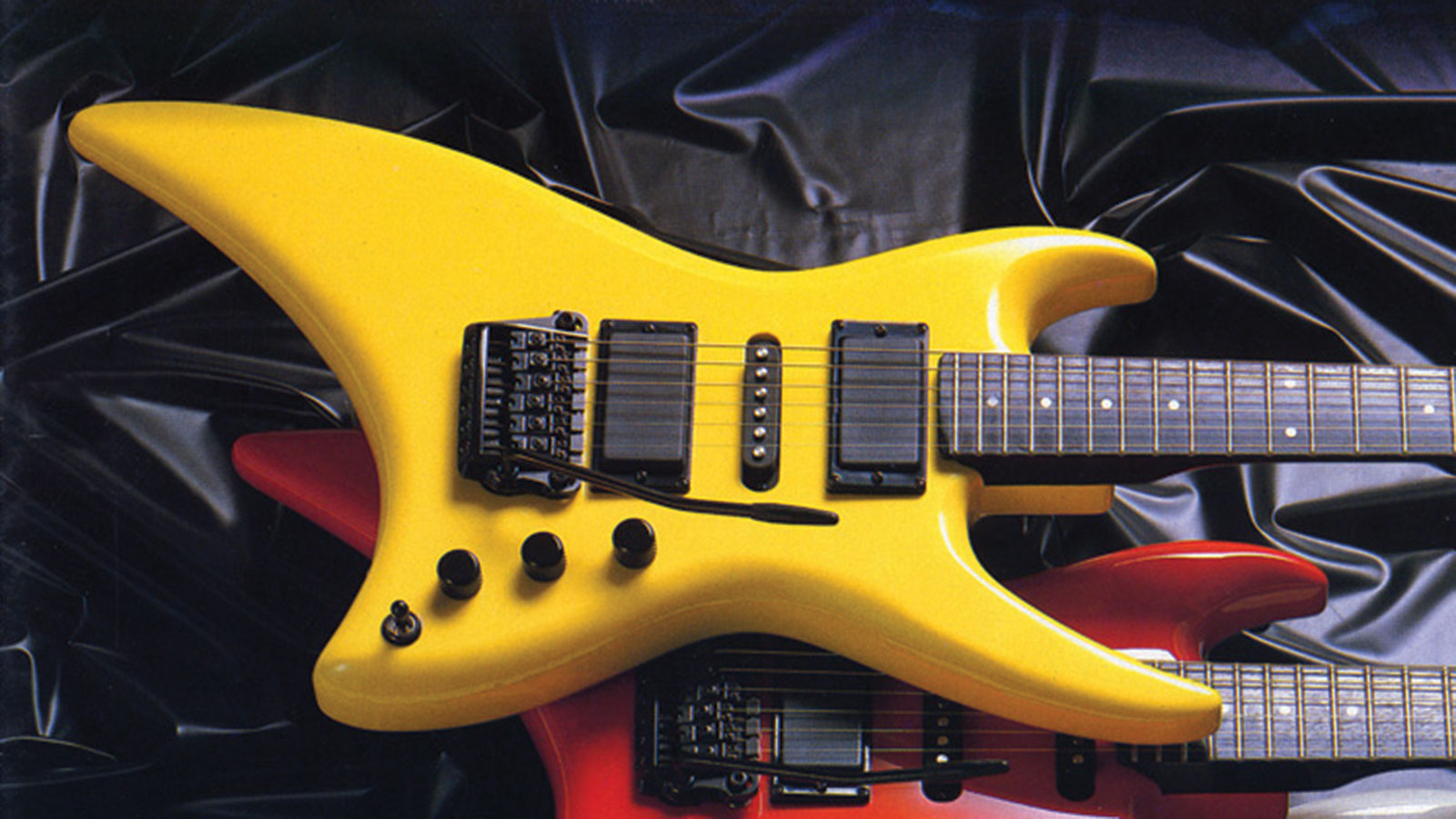
Ibanez also officially revived the Iceman model in 1995, partially thanks to demand sparked by its use by J. Yuenger of White Zombie. J’s signature model followed shortly after, along with a new Paul Stanley model that was released in time for Kiss’s original lineup reunion tour.
On a completely different end of the musical spectrum, Ibanez finally brought its long relationship with jazz guitarist Pat Metheny to fruition with the introduction of his first Ibanez signature model in 1996.
Although musical trends during the Nineties would suggest otherwise, Ibanez’s RG, S and Steve Vai and Joe Satriani signature models continued to sell well during this period. As a result, they have retained a consistent presence and prominence in the Ibanez catalog every year and have become standards to several generations of players in much the same way as the Gibson Les Paul and Fender Stratocaster and Telecaster before them.
5: Scaling up

As Ibanez entered the new millennium, its status as one of the industry’s top 10 guitar companies remained solid. Compared to most of its main competitors, Ibanez enjoyed a distinctive reputation as a company that was known both for offering new models and innovations as well as having a consistent lineup of standard models.
Today Ibanez offers electric solidbody signature models for 25 different artists that represent a wider variety of styles than ever
The company also remained a magnet for new, upcoming generations of talent, continuing the company’s legacy of developing new innovations through collaborations with visionary artists.
Although Ibanez started offering Prestige models during the mid Nineties, which were made by the company’s best luthiers in Japan using premium-quality materials, refined neck designs and fret treatment, and pro hardware and pickups, the Prestige concept really took off in the early 2000s.
The Prestige models adopted many new ideas and concepts suggested by players, and the series also offered customers the highly refined qualities of a boutique instrument for a fraction of the expense.
In 2007, Ibanez introduced the very first mass-produced eight-string solidbody electric model, the RG2228. The company’s production of several different eight-string models over the years led to the Tosin Abasi series signature eight-string models, which the company offered from 2013 through 2017, when Abasi left to start his own guitar company.
The company also produced an eight-string Meshuggah signature model, introduced in 2012. Further pushing the envelope of the guitar’s tonal range, Ibanez’s first nine-string models made their debut in 2015.
Ibanez introduced the Iron Label Series of guitars designed specifically for modern metal players in 2013. The company’s first multi-scale guitars appeared in the Iron Label lineup in 2016.
Ibanez’s continuing dedication to modern, innovative instruments is reflected by the new Q (or Quest) Series, which feature a compact and ergonomically comfortable modernistic head- less design and innovations like eight-degree inward slanted frets that enhance contemporary technical playing styles.
Today Ibanez offers electric solidbody signature models for 25 different artists that represent a wider variety of styles than ever, including punk guitarist Noodles of the Offspring, Nita Strauss, blues-rock virtuoso Josh Smith, Polyphia’s Tim Henson, math rocker Yvette Young of Covet and modern jazz fusion specialist Tom Quayle.
The Lari Basilio LB1 signature model is a surprising best seller considering that the Brazilian artist only broke through to a wider international audience over the last few years.
Steve Vai models remain best sellers as well. His newest signature model, the PIA3761, exceeded projections to the extent that Ibanez had to stop taking orders as their production was unable to keep up with the demand.

“Artists are critically important to what we do,” Miller says. “Our custom shop is like a player’s laboratory, and artists are our direct line to what players really want and what is trending out there. They often give us critical feedback about what features work best for them in an instrument, which is information we’ll consider when designing and manufacturing our production models.”
Miller says that one of the keys to Ibanez’s longevity and success is its willingness to adapt and constantly seek ways of doing things better. “New ideas are encouraged here,” he explains, “whereas many other companies generally tend to work within solidly drawn lines.
“We’re also not afraid to fail. There’s a saying that goes, ‘The master has failed more times than the beginner has tried.’ Not all of our products have been successful, but when they’re not we’re not afraid to learn from the experience and move on. Fortunately, in the last five years we’ve had a lot more hits than misses. We truly pay attention to our artists and customers to deliver what musicians really want.”
Chris is the co-author of Eruption - Conversations with Eddie Van Halen. He is a 40-year music industry veteran who started at Boardwalk Entertainment (Joan Jett, Night Ranger) and Roland US before becoming a guitar journalist in 1991. He has interviewed more than 600 artists, written more than 1,400 product reviews and contributed to Jeff Beck’s Beck 01: Hot Rods and Rock & Roll and Eric Clapton’s Six String Stories.











